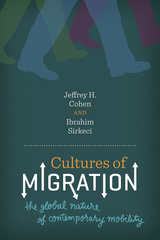Oaxaca in Motion
An Ethnography of Internal, Transnational, and Return Migration
Migration is typically seen as a transnational phenomenon, but it happens within borders, too. Oaxaca in Motion documents a revealing irony in the latter sort: internal migration often is global in character, motivated by foreign affairs and international economic integration, and it is no less transformative than its cross-border analogue.
Iván Sandoval-Cervantes spent nearly two years observing and interviewing migrants from the rural Oaxacan town of Santa Ana Zegache. Many women from the area travel to Mexico City to work as domestics, and men are encouraged to join the Mexican military to fight the US-instigated “war on drugs” or else leave their fields to labor in industries serving global supply chains. Placing these moves in their historical and cultural context, Sandoval-Cervantes discovers that migrants’ experiences dramatically alter their conceptions of gender, upsetting their traditional notions of masculinity and femininity. And some migrants bring their revised views with them when they return home, influencing their families and community of origin. Comparing Oaxacans moving within Mexico to those living along the US West Coast, Sandoval-Cervantes clearly demonstrates the multiplicity of answers to the question, “Who is a migrant?”
Cogent portraits of the individuals and families [Sandoval-Cervantes] followed in both the home community and their migrant settings in Mexico and the US…Recommended.
[A] readable and insightful book…[Oaxaca in Motion] is an excellent introduction to the gender analysis of migration studies.
A generous and engaging book, Oaxaca in Motion is must reading for every class on Mexican migration and gender studies.
A compelling and poignant book wherein every page traces Sandoval-Cervantes’s respect and affection for the Mexicans he came to know. Oaxaca in Motion sharpens and reworks our theories of migration by both widening and deepening the lens.
Iván Sandoval-Cervantes is an assistant professor of anthropology at the University of Nevada, Las Vegas.
- Acknowledgments
- Introduction: Noticing Internal and Transnational Migrations
- Chapter 1. Research in Zegache: Multiple Histories
- Chapter 2. Leaving Zegache: Internal and Transnational Women Migrants
- Chapter 3. Labor Corridors I: Peasants and Soldiers
- Chapter 4. Labor Corridors II: Transnational Migration and Masculinity
- Chapter 5. The Masculine Familiarity of Work; or, How Cooking Became Masculine
- Chapter 6. Migration and Femininity: Beyond the Tutelage of the Mothers-in-Law
- Conclusion
- Notes
- References
- Index







